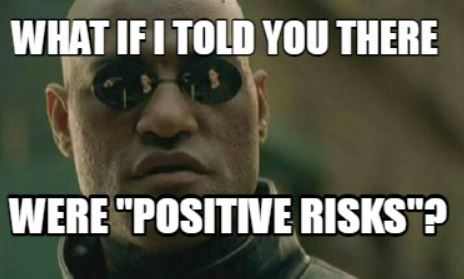 Similar to my previous article, this topic stemmed from a discussion I had with the learners of the PMP preparatory course I taught this week.
Similar to my previous article, this topic stemmed from a discussion I had with the learners of the PMP preparatory course I taught this week.
While presenting the project risk management knowledge area from the PMBOK framework, when I indicated that while in our daily conversations risks are usually threats there can be positive risks as well, I was met with some disbelief and skepticism.
In past article I’ve frequently quoted Dr. David Hillson’s definition of risk as being “uncertainty that matters“. That definition recognizes both threats and opportunities.
However, in my past experience I’ve almost never seen a group of stakeholders consider the upside of risks with their project. Very few of the companies I’ve worked with did a great job at managing threats to their projects so expecting their teams to go that extra mile and effectively manage opportunities might be too much of a stretch. I’ve even recall one sponsor telling me “We have little time on our projects to do more than complete the must-have deliverables and now you want us to think about what to do if things work out better than we expected?“
So I decide to do another poll in PMI’s LinkedIn discussion group , asking practitioners to vote whether they did or did not consider opportunities in their most recent projects.
The results were a little surprising.
While the majority of responses (57%) indicated that the risk management focus was solely on threats I was expecting that number to be much higher.
The comments I received highlighted why positive risks are rarely referenced in practice.
- It can be difficult explaining this idea of positive risks (opportunities) to non PM people and this sometimes gets an eye-roll from my audience when explaining why/how we should exploit it.
- If you call it an ‘opportunity’, it will probably resonate more. A positive risk is not something recognized outside of the PM space.
- No, for one primary reason – the idea of positive risk is largely a pm/risk mgmt construct, and one the ‘regular world’ doesn’t share or understand. Ask anyone to invest money and they’ll ask ‘is it risky?’. They’re not asking for the probability that they will *make* money, they’re wondering the likelihood that they’ll *lose* it (the risk).
So perhaps it is time to lose the term “positive risk” from our parlance, and split opportunity management off from the project risk management knowledge area. While there is a strong overlap between the practices within these two domains, the perception of each is sufficiently different that separating them might encourage stakeholders to actively manage both the up and downside of risk.
(If you liked this article, why not read my book Easy in Theory, Difficult in Practice which contains 100 other lessons on project leadership? It’s available on Amazon.com and on Amazon.ca as well as a number of other online book stores)
